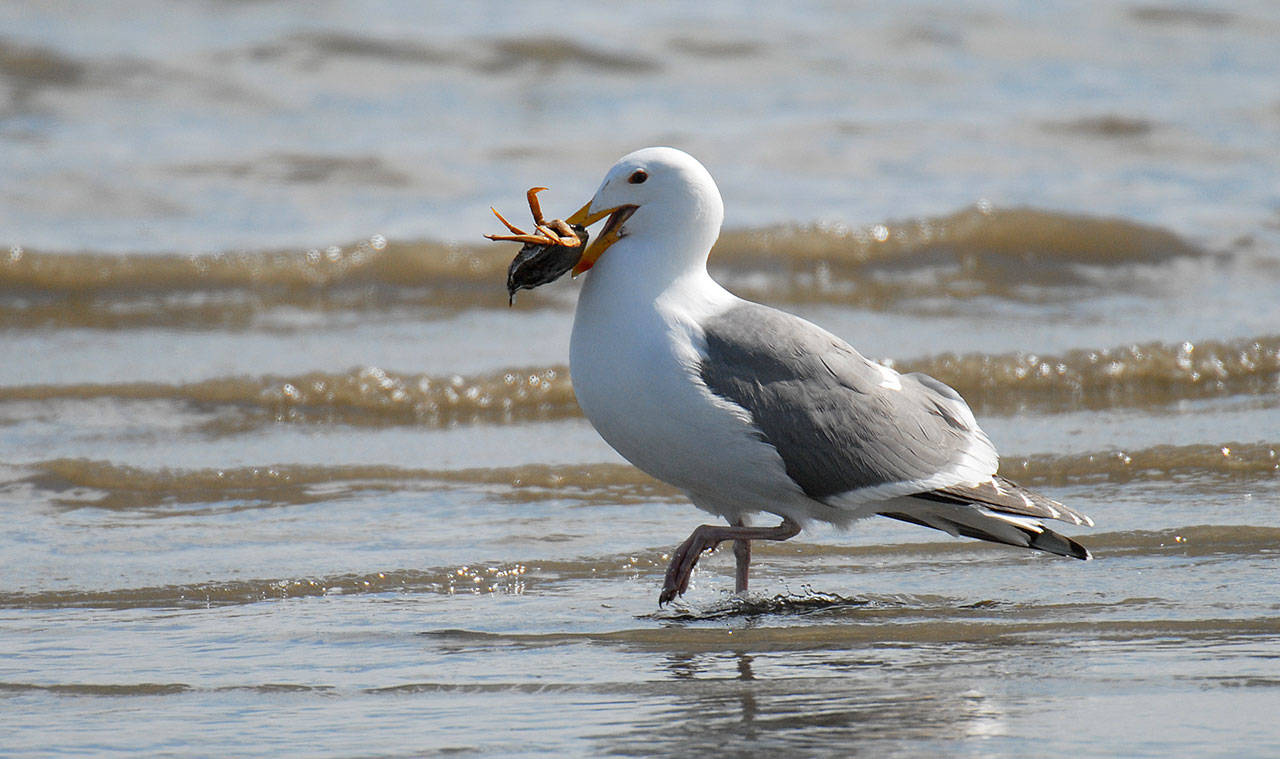The minute crabbing season opens, I begin to notice our gulls.
My husband and I spend more time at the beach untangling the crab pot line, making sure the trap is weighted so it won’t drift away with the currents, baiting the trap and rowing the dingy nearly out to the drop off. We paddle around a bit looking for the perfect spot to drop our pot. Then we leisurely row back to shore.
If the trip out is successful and crabs are scraping at the inside of our bucket, the gulls reach the shore before we do. They know any leftover crab bait will be tossed their way and later, after the crabs are cleaned, they’ll consume a gooey feast.
When crab season opens around the first of July, the most common gull around Whidbey is the glaucous-winged gull. It’s our typical gray and white, yellow-billed, pink legged, Ivar’s fish-and-chips gull. They hang around our ferry docks and any place where food is waiting to be scavenged.
A couple of these gulls usually nest on top of the dolphins (those pilings that direct the ferries into the loading docks) at both Clinton and Keystone. Scampering up to the passenger deck at the end closest to the dock and looking down on the pilings before the boat departs may offer a bird’s eye view of the nests.
Glaucous-winged gulls also like to lay their eggs on the flat roofs of buildings near the water. They create a simple nest of dried grass or seaweed.
By the end of July, the young begin leaving their nests. These milky-brownish feathered gulls are the same size as their parents but still depend on them for food. The juveniles emit a high-pitched plea for attention from their parents, or any other gull-like bird on the beach. They will beg for food into the fall, but eventually learn to scavenge on their own.
And scavenge they do! These gulls frequent garbage dumps, will eat carrion, fish, invertebrates and seaweed. They might even grab a rabbit or pigeon as well as other birds’ chicks.
If you’ve spent any time on one of our beaches, you’ve seen a glaucous-winged gull take a clam or barnacle in its beak, fly high above a hard surface and drop the food item to break it open. The bird swoops down quickly to consume the prize, knowing that other gulls are waiting to dart in and snatch the snack.
By the time crabbing season closes around Labor Day, several more gull species will have joined the glaucous-winged gulls on our beaches. Smaller, black-headed Bonaparte gulls likely will arrive first. They’re followed by the distinctive Heerman’s gull with a darkish body, white head and red bill. Also, mew, California and ring-billed gulls will gather. And fewer herring and thayer’s gulls will mix into the flocks.
Gull identification is a bird watchers challenge or nightmare, depending on the experience of the birder. The adult birds have only subtle differences and the young molt through several phases of coloring before attaining adult plumage. And to confuse the identification process even more, some species crossbreed to create a hybrid.
Another gull-looking bird to watch for is the elegant Caspian tern, the largest tern in North America. A stark black head cap and a large, red-orange, carrot-like bill identify these long-winged, white-bodied birds. Caspian terns patrol the water off our beaches searching for fish. In a dramatic change of direction, they plunge-dive into the water to catch prey.
By fall, up to nine species create a mélange of gulls and terns sailing over our beaches, gathering at fresh water outfalls, topping pilings and settling on docks, boats and decks.


